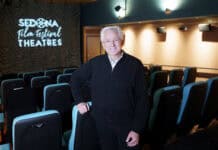Over their last two meetings, the Sedona Planning and Zoning Commission has spent several hours trying to define what a campground is — not to mention what glamping is — in order to best utilize the recently created Oak Creek Heritage District.
In the end, the commission’s recommendation to the Sedona City Council on Tuesday, Oct. 20, was that “campground” and “camping” be eliminated from the Schnebly Hill Community Focus Area and Oak Creek Heritage District. “Semi-permanent,” “rustic” and “tent-like structures” were terms staff was recommending to help define lodging within the CFA. However, the commission recommended not including these terms in the amendments to the CFA and Land Development Code. In addition, they recommended that the maximum number of RVs allowed on a site be eight per acre.
The Oak Creek Heritage District falls within the Schnebly Community Focus Area, which sits between Schnebly Hill Road and Oak Creek.
A city report states that from the Sept. 15 commission work session discussion it became clear that better definitions were needed for campgrounds, RVs and lodging uses.
“If campgrounds and camping were to be removed as an allowable use, then the line between campgrounds and lodging needed to be clearer,” Senior Planner Mike Raber said.
Based on this discussion, staff proposed a series of amendments that focus on the following:
■ Separation of the definitions for campgrounds and RV parks.
■ Removal of campgrounds as an allowable use in the Community Focus Area and Land Development Code.
■ Creation of definitions for RVs and RV parks that is limited to recreational vehicles that are self-propelled or drawn by another vehicle.
■ Retention of RV parks as an allowable use within certain limits. Staff believes this is preferable to the elimination of RV uses entirely.
■ Creation of a new lodging definition allowing for alternative lodging types such as cabins and other similar permanent structures, not including RVs or tents.
Also approved was staff’s recommendation for language defining an RV park. It states, “An RV park is an outdoor facility designed for accommodation in RVs for recreation, education, naturalist or vacation purposes. An RV is a mobile structure designed as temporary living quarters for recreation, vacation, camping or travel use, which is either self-propelled or is mounted on or drawn by another vehicle. Examples include, but are not limited to, a travel trailer, camping trailer, fifth-wheel trailer, truck camper, motor home or camper van.”
Rancho Sedona RV Park off Schnebly Hill Road, is grandfathered and thus is not affected by the proposed updates. However, the new guidelines would limit Rancho Sedona and future RV parks to eight units per acre once the properties are rezoned to the Oak Creek Heritage District. As it stands now, the RV park is a non-conforming use in a residential zone. Currently, Rancho Sedona is included in the rezoning application as part of the heritage district, but they have not specifically requested eight units per acre. Right now they are just under eight RV spots per acre.
The Oak Creek Heritage zoning district intends to provide options for development designs that will preserve the character of the area by incorporating a network of natural open space and pathways into developments to create a park-like, walkable district. The district would allow for single-family homes or multi-family residential complexes, lodging, agriculture, parks, recreation and open space. Commercial use is limited.
